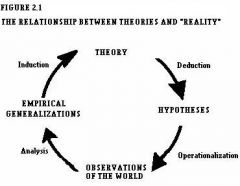![]()
![]()
![]()
Use LEFT and RIGHT arrow keys to navigate between flashcards;
Use UP and DOWN arrow keys to flip the card;
H to show hint;
A reads text to speech;
38 Cards in this Set
- Front
- Back
|
Four Ways of Knowing
|
Religion Logic Science |
|
|
Ideology
|
|
|
|
Religion
|
A set of beliefs that concern the dictates of some supernatural entity. |
|
|
Logic |
A system of reasoning in which specific rules are applied (closely linked to science). |
|
|
Science
|
A set of operations applied to create or understand what is going on around us. |
|
|
What is x? |
|
|
|
What is y? |
|
|
|
What is z? |
Z variables are outside factors that also affects the y variable. Also known as exogenous or intervening variables. |
|
|
Four Basic Assumptions |
Knowledge can explain the workings of natural, empirical world. Knowledge based on science can be revised. Science creates knowledge for its own sake, not for the support of policy or ideology. |
|
|
How does science differ from common sense? |
Laypersons use little control to test their theories while scientists try to control the intervening variables. Scientists disregard metaphysical explanations. |
|
|
How does science operate?
|

Science operates in a circular fashion so it is constant, can begin anywhere, and can answer or lead to other questions.
|
|
|
What is the definition of theory?
|
A set of two or more, logically interrelated empirically testable propositions for the purpose of explaining or predicting phenomena |
|
|
What are the components of theory?
|
Must be related Must be empirically testable or measurable Only phenomenon |
|
|
Observation |
|
|
|
Hypothesis
|
|
|
|
Generalizations |
A common pattern |
|
|
What is perspective?
|
A worldview that selects and organizes our sensory experiences. The selection is rooted in both our physiology and our language. |
|
|
What are the errors in personal inquiry? |
Ecological fallacy (overgeneralization) Selective observation Ex post fact hypothesizing Illogical reasoning Ego involvement in understanding Ideology and politics Premature closure of inquiry |
|
|
What are the general characteristics of perspective?
|
Organization - your ideology and personal beliefs will "color" how you view things |
|
|
Principles of scientific perspective |
Objectivity Relativism Skepticism Ethnical neutrality Parsimony Determinism Control intervening variables |
|
|
Empiricism |
Scientists seek answers to questions through direct observation of events being studied |
|
|
Objectivity
|
Conclusions are based on careful observation rather than personal prejudices.
|
|
|
Skepticism |
Scientists have to be wiling to question everything, especially common sense and common knowledge. |
|
|
Ethnical neutrality |
Scientists have to try not to permit their moral or ethical beliefs influence their data gathering and conclusions. |
|
|
Parsimony
|
The numerous alternative explanations of a particular phenomenon should be reduced to the smallest number possible. |
|
|
Determinism |
Every event is preceded by one or more other events which cause it to occur |
|
|
Two ways scientific process can proceed
|
Inductive |
|
|
Deductive
|
Theory >> Observations |
|
|
Inductive
|
Observation >> Theory |
|
|
Causality
|
|
|
|
Steps to establishing causality. |
Temporal sequencing Elimination of rival factors |
|
|
Concomitant variation |
When variable changes, so must the other, no matter the relationship. |
|
|
Positive relationship |
When one variable goes up, the other goes up as well. |
|
|
Inverse relationship |
When one variable goes up, the other goes down. |
|
|
Temporal sequencing |
Cause must precede the effort |
|
|
Elimination of rival factors |
Rival causal factors must be excluded |
|
|
Four basic models of causality |
Multiple causality Interactive model Dialectical causality |
|
|
|
|

